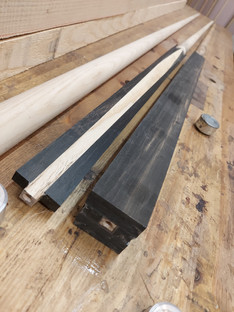
























Cue Making
Making cues is an artform which cannot be rushed. They are not mass produced items churned out on a production line, far from it. The images above give an idea of how Lonergan Cues are made, from the initial selection of the boards to the final finishing. Hopefully this highlights the precision hand work involved and gives you an idea of how and why lead times can vary.
I make cues in a traditional way. Hand planes are the tools of the trade and are used exclusively to prepare all exotic timbers used and splice every shaft that leaves the workshop.
Timber selection
The first and most critical step in making first class, handmade cues is the selection of timber.
Many hours are spent searching for Ash and Maple suitable for cues. Grain pattern, colour, density are all considered. On the latest hunt for timber the boards were 16ft long and rough sawn - just a couple of the challenges faced when trying to find suitable timber.
Out of around 250 boards, only 5 were suitable on this particular occasion.
This is not uncommon - on a bad day none are selected. It is essential that I am very demanding when it comes to quality, I will not purchase boards simply because that day has been put aside to find raw material. If it's not good enough it stays in the timber yard.
Cutting & Tapering Blanks
All boards are cut into blanks. This is where the grain begins to show itself and I get a better idea of what piece will be useable.
After being cut, it is left for a number of weeks to settle which allows any movement in the timber to show itself.
This is the stage in which I get a better idea of what will be useable and what wont. It is at this point that the shafts can be graded based on two factors; looks and performance. Unfortunately the demand for looks means that some of the best playing shafts never get made into cues - it's a bizarre trend but over the last 7 or 8 years 'perfect' arrows are increasingly in demand.
Once tapered these are again left to settle for a couple of months to ensure that any movement shows itself. They are oversized at this point, roughly 32mm at the base and 12mm tips.
Hand Splicing
Once the shafts have settled they can be spliced. Hand splicing means exactly that. The shafts have two flat faces planed away and ebony splices glued onto them. The process is then repeated on the other two faces.
The only tools used for this stage of the process are razor sharp hand planes. Nothing else is required. This is where perfection is key and cannot be rushed. It's essential to take the time to get the splices as accurate as possible in both size and shape. This is the stage where I aim to get top and bottom splice points as even as possible.
Once 4 splices have been added and the adhesive has cured the excess ebony can be worked away and the basic cue is formed.
At this stage if any decorative splices are required they can be added in the same way. A flat is planed and decorative timber glued into place.
Multi spliced cues take a lot more work and use a lot more timber. For that reason, the lead time will be longer and the price will be higher than a plain ebony butt cue.
Tapering / Weighting / Ferruling
Once all required splices have been added the cue can be tapered to its final spec. This is done slowly and gradually using hand planes.
The ferrule will be made to spec and fitted and then the cue can be roughly sanded and have all grain filled and sealed. I make my own grain filler - it is formulated to fill and stain the pores of the timber and fill out the grain to ensure a perfectly smooth finish. Black is traditional, but in theory it could be whatever colour you wanted!
Lead weight is almost always necessary. Very rarely would a the natural weight of a cue be more than 16oz.
The butt is drilled using the lathe and lead added to reach the required weight. This is also when I would finalise the balance point of the cue and add the mini butt joint if required.
Fine Finishing
Once the weight is added the cue will be badged and then fine sanded by hand. This process is done over a number of days, the end result is a beautifully smooth cue ready for oiling.
Lonergan cues are finished using a blend of oils which give an outstanding finish. These oils are available in a number of different tints, meaning you can have an aged look to your cue if you would like.
They are hard wearing and water resistant, two essential qualities. This part of the process cannot be rushed and can easily take a week or more to complete.
Tipping
The tip is the final piece of the puzzle. There are an unbelievable amount of tips on the market now and I don't try to keep up! If you want something specific then you can request it and we will fit it. Otherwise your cue will be fitted with an Elkmaster selected to ensure it's not too hard or too soft.
Order Now!
Get in touch to order yourself a unique, hand crafted, made to measure cue.
It wont pot balls for you but you can take confidence from the fact that you are using an instrument made from the finest materials that wont let you down!